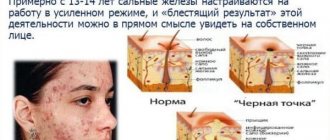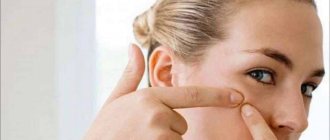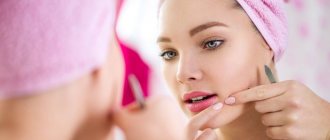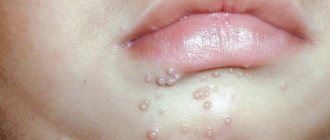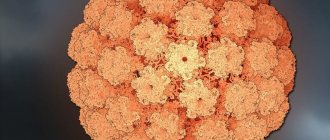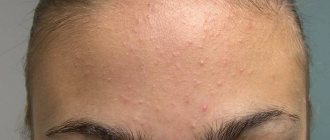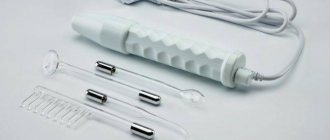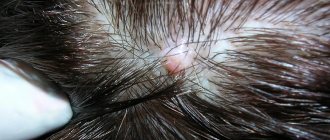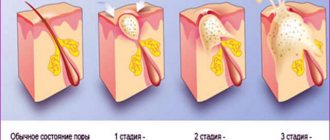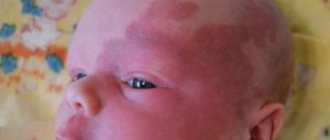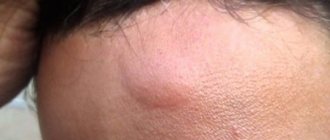When a person discovers pimples on the scalp, he thinks that they appeared due to insufficient care. What women, and even men, do in order to get rid of this defect: they wash their hair with amazing frequency, use cosmetics, including homemade ones, wipe the skin with alcohol, which leads to dry hair. But the reasons for the problem can be very diverse, and if all attempts to overcome acne on the head turn out to be in vain, then it is recommended to make an appointment with a highly specialized specialist - a trichologist.
Causes of acne on the head in women
Even a very tiny pimple can cause serious discomfort. What if there are several of them? Or worse, a rash appeared on your scalp? Itchy and painful pimples do not even allow one to comb normally, not to mention performing more complex and significant manipulations for a woman (styling, for example).
Before starting the fight against acne, it is necessary to establish for certain the causes of its appearance, which is sometimes only possible in a medical setting.
It is noteworthy that the reasons can be both external and internal.
External factors
- Washing your hair too rarely or, conversely, too often.
- Night rest on pillows made of synthetic materials. During sleep, the scalp sweats and does not “breathe,” which leads to inflammation.
- Washing your hair with hard or highly chlorinated water, which dries out your hair, activates the sebaceous glands.
- Incorrectly selected shampoo, one of the components of which may act as an allergen. If a woman uses hair balm or masks, then such cosmetics can also cause allergies.
- Refusal to wear a hat during the cold season. This can not only cause acne, but also cause hair loss.
- Bad ecology.
- Poor nutrition. Lack of vitamins and minerals, excess fat and sugar negatively affect the entire body, and the scalp in particular.
- Use of anabolic and hormonal drugs.
Internal factors
- Hypothermia, colds. These processes can be accompanied by the appearance of acne all over the body, the scalp is no exception.
- Stress. They “hit” not only the nervous system, but also the adrenal glands, which leads to disruptions in the functioning of the entire body, which can react to this in any way.
- Unstable hormonal levels. Disruptions occur not only due to pregnancy, childbirth or menopause. A decrease in estrogen levels in the female body often causes acne to appear on the chest, back, face and scalp.
- Polycystic ovary syndrome. This organ of the female reproductive system, in the presence of such a disease, is forced to work in an intensive mode, which leads to an increase in the oiliness of the skin. Because of this, pimples can appear anywhere.
- Hormonal surge before menstruation. PMS can manifest itself in a similar way.
- Some skin diseases. Among them we can safely include seborrhea, the appearance of which occurs for purely internal reasons, although many blame bad heredity for this. Also, head lice, eczema, psoriasis and demodex attack cannot be ruled out.
What is important to consider during treatment?
We recommend reading: Indian hair cosmetics, what you need to know
If pustules begin to appear on the scalp, then under no circumstances should you squeeze them out. Due to damage to the skin, you can introduce more infections into the wound. If there are too many such manifestations, then they can indicate quite serious problems in the body. Even infection by a virus is possible. Trying to squeeze out pimples will only make the situation worse and treatment will become more difficult.
Maximum attention must be paid at the moment when you wash your scalp. This must be done so gently and delicately so as not to scratch or damage the existing pustules. It is even more important to dry your hair carefully.
Folk remedies and treatment in this case are also relevant. You can use infusions of medicinal herbs such as calendula, yarrow, and celandine. Most often, hair is rinsed with the product after it has been washed.
If simple remedies do not help, and the situation does not improve, but only worsens, then it is still advisable to visit a dermatologist.
READ ALSO: Red pimples on the body: possible causes of rashes
Pimples on the head in men: causes and factors of their appearance
Pimples on the scalp are very frustrating for men of all ages, because they cause a lot of inconvenience and are more noticeable (most men prefer to have their hair cut short).
Hormonal and internal disorders and lack of hygiene are just some of the reasons for the appearance of such defects. Acne is often a symptom of a disease, such as rubella.
But most often they appear in young men going through puberty. During adolescence, the activity of the sebaceous glands increases, which leads to the appearance of acne in different parts of the body. Normally, the problem disappears on its own after reaching the age of twenty.
Provoking factors
- Using low-quality shampoos or insufficiently frequent hygiene procedures.
- Professional activity. An increased concentration of dust in the air, working with oils and chemicals, high or low air humidity, sudden temperature changes - all this can fully contribute to the appearance of acne, and not only on the head.
- Eating fried, spicy, fatty foods, as well as bad habits.
- Wearing a helmet, hard hat and other hard headgear.
- Long hair (unfortunately, not all men know how to properly care for their hair).
- Habit of ruffling hair and scratching scalp. It is unlikely that such actions are performed with clean hands; moreover, the penetration of bacteria into the deep layers of the epidermis is greatly facilitated by the mechanical effect on the scalp.
- Shaving the hair on the head. They can be shaved with a blade that is not very sharp or in the wrong direction, which leads to the appearance of ingrown hairs, which are the root cause of acne.
As for the reasons for the appearance of pimples on the head, they can also be external and internal. It happens that such a defect occurs due to the fact that a man is under stress for too long, suffers from eczema, psoriasis or other diseases.
Hair inflammation in men
If women are sometimes characterized by excessive attention to beauty and hair care, then men often neglect this. On the other hand, shorter haircuts reduce the risk of inflammation of the epidermis of the head, since they provide contact with air. However, there are acne in this part of the body that is typical only for men.

They are related to:
- Wearing tight protection or uniform hats. Helmets, helmets, and caps are rarely cleaned and washed from the inside; moreover, they block air access and create the so-called “greenhouse effect.” The head sweats, and microorganisms multiply faster in a favorable environment.
- Shaving the head with a machine, as a result of which the hair follicles are injured, irritations appear, which serve as a gateway to infection.
- Harmful working conditions associated with dust or exposure to aggressive chemicals, such as coal dust, chlorine and other halogens, paper dust, small wood particles.
Important! If a man wears long hair or exotic hairstyles, such as dreadlocks, he needs to be more careful in caring for his hair and scalp. Due to the activity of male sex hormones, the skin secretes more sebum than in women. Men's hairstyles get dirty faster, and the epidermis is more sensitive to dryness.
Why do acne appear on the scalp in children and adolescents?
A newborn baby's head may become covered with pimples due to the fact that his mother does not eat properly. Sometimes young children become victims of allergies, which manifest themselves in the form of a red rash.
Any food product, cosmetics, plant pollen, fabrics, animal hair, etc. can also act as an allergen. It happens that pimples on the head signal the onset of a disease (chickenpox, rubella).
Parents of infants should pay attention to every pimple that pops up. As for teenagers, the fact that acne appears on the scalp should not surprise anyone, because similar defects appear on other parts of the body. And this is caused by puberty, which is invariably accompanied by a “hormonal storm.”
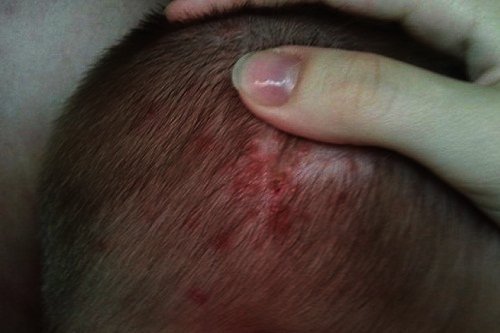
Causes of skin pathology
To begin with, it should be noted that this condition is typical for both adults and children. As for provoking factors, experts identify the following causes of ulcers on the head in the hair:
- Hormonal imbalance.
- The occurrence of an allergic reaction to hygiene products, as a result of which ulcers appear on the head in both the child and the adult.
- Stressful situation.
- An infectious process against the background of an unsatisfactory state of immunity.
- Damage to the adrenal glands.
- Unbalanced diet.
- Polycystic ovarian disease, as well as pregnancy.
- Failure to comply with personal hygiene rules.
- Washing your hair with poorly purified water.
- And finally, the manifestation of an allergic reaction.
Treatment of acne on the head
Treatment methods for acne vary depending on the reasons that caused it and the type of defect. In any case, it is better to consult a specialist doctor - a trichologist. It is possible that you will need to consult other doctors - an immunologist, therapist, gynecologist, endocrinologist, and possibly an oncologist.
The fact is that skin cancer often provokes the appearance of pink “waxy” bumps. In addition, the concentration of acne in the back of the head is observed in HIV-infected people and people suffering from lupus.
Providing proper care for your scalp and hair, as well as reviewing your diet and lifestyle, will all help get rid of acne if its appearance is caused by a lack of hygiene and “simple” and non-hazardous reasons.
Cosmetology and medicine
Getting rid of acne requires an integrated approach, and therefore, along with medications, the patient may be prescribed physiotherapeutic procedures, which are carried out in a cosmetology office. For example:
- Laser therapy.
- Cryotherapy.
- Ultrasound vibration therapy.
- Treatment of the scalp with ultraviolet light.
- Darsonvalization.
Medication methods
In complex clinical cases, the doctor may prescribe antibiotic drugs, and in the presence of concomitant diseases, the patient may be prescribed multivitamin complexes, hormonal and other medications.
To eliminate toxins released by acne, adsorbents (brewer's yeast, Lactofiltrum, Polysorb, etc.) are prescribed. If the doctor sees that the problem can be eliminated with the help of ointments, gels and suspensions that have an antiseptic, anti-inflammatory and drying effect, then such drugs are recommended for use.
It is noteworthy that their use should be “targeted”!
The following are considered particularly effective:
- Ichthyol ointment;
- Levomekol;
- Tincture of calendula;
- Skinoren;
- Zinc ointment;
- Metrogil;
- Effezel;
- Tetracycline ointment;
- Preparations containing salicylic acid.
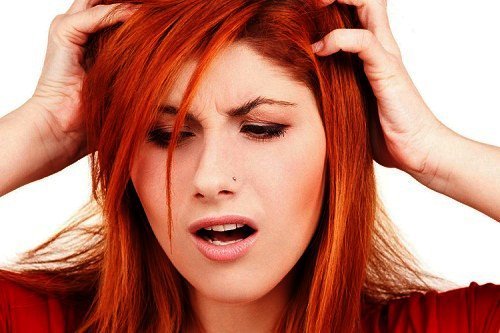
Where to start treatment?
First of all, you need to consult a dermatologist. He will examine your scalp with a dermatoscope and be able to tell you the probable cause of your acne. Sometimes additional examinations .
If the problem is purely cosmetic, it will be easier to fix. The specialist will tell you what and how to do. But in case of a more serious course of the disease, the dermatologist will send you for a consultation with some other specialists specializing in the treatment of internal organs and systems .
In some cases, it may be enough to change your diet or shampoo. In others, you will need to undergo long-term treatment.
In any case, it will include both taking medications internally and special external care .
To completely get rid of acne on the head, you will have to eliminate all allergens that can cause such a reaction, including alcohol and cigarettes with their huge amount of harmful substances.
Folk remedies for acne on the head in the hair
- Distribute the crushed plantain leaves along with the pulp and juice evenly over the entire head and leave the pulp for half an hour, then rinse.
- Boil the hop cones for 5 minutes, let the broth brew, then apply it to each pimple.
- Apply grated pumpkin to your head, and after 20 minutes, rinse off the paste with warm water.
- Soak a cotton pad in a strong solution of sea salt and wipe each pimple.
- Rinse washed hair with a mixture of water and apple cider vinegar (1:1).
- Periodically wipe your scalp with freshly squeezed strawberry juice.
- Add a few drops of tea tree oil to your shampoo. This drug can also be used in its pure form - wipe each pimple with it.
- Colorless henna is an excellent and inexpensive remedy for combating ulcers. Instructions for use are on the packaging.
General rules of treatment
Patients often make one mistake: they begin to squeeze out the contents of the inflamed capsules. The result is disastrous: the infection spreads to new areas, the number of ulcers increases. In severe cases, serious complications are possible.
How to get rid of acne on your head? Ten basic rules of treatment:
- do not squeeze out the contents of inflamed comedones;
- visit a dermatologist or trichologist, get examined by specialized specialists;
- review your diet;
- give up bad habits;
- spend more time caring for your hair;
- combine medications and traditional medicine recipes;
- refuse synthetic fabrics in bed linen;
- avoid stressful situations;
- choose high-quality cosmetic products without irritating components;
- take immunomodulatory drugs and multivitamins.
READ ALSO: Signs and symptoms of oily seborrhea of the scalp: causes, general treatment rules, effective traditional medicine recipes
Drug therapy
Effective drugs and procedures:
- camphor alcohol. Wipe acne clusters, treat the skin gently, without pressure. Apply the active product only to the affected areas, do not lubricate healthy skin: irritation and itching will occur. Salicylic alcohol shows good results;
- anti-inflammatory ointments. Levomikol, Zinc, Erythromycin ointment, Synthomycin emulsion give excellent results. In each case, the medication is selected taking into account individual characteristics. Wash your hair, dry your strands, lubricate the affected areas with the prescribed product. Do not use ointments more than normal;
- tar soap. Before washing your hair, treat the ulcers with an active antiseptic. Soap foam relieves inflammation and dries the skin;
- Vishnevsky ointment, Ichthyol ointment. Both drugs have long been successfully used to eliminate inflammatory processes in various parts of the body. For single pimples, lubricate the inflamed area, cover with a bandage, and secure with a band-aid. If there are numerous ulcers, carefully lubricate the affected areas with the composition, do not treat healthy skin;
- antibiotics. Doctors prescribe potent drugs only in severe cases, when there is a threat of infection spreading over a large area, or possible blood poisoning. Amoxicillin, Erythromycin, Tetracycline are effective. At the same time, take medications that restore intestinal microflora, for example, Linex;
- UV irradiation sessions. Dermatologists often prescribe an effective procedure to reduce inflammation. UV rays suppress the activity of pathogenic microbes and dry out the epidermis. Sessions are conducted in medical institutions and specialized cosmetology clinics.
Learn all about using ylang-ylang essential oil for hair.
Look at photos of sesson haircuts for short hair on this page.
Follow the link to read about the use and composition of Zincteral for hair loss.
Recipes and traditional medicine
Treat inflamed areas with decoctions of medicinal herbs, apply compresses made from natural ingredients, and lubricate the affected areas with homemade tinctures. To wash your hair, use a medicated shampoo that you prepare yourself.
Before using traditional recipes, consult a dermatologist or trichologist and find out which products are suitable in your case. Avoid using mixtures that irritate the skin.
Proven recipes for treating acne on the head under the hair:
- aloe for acne. Cut a piece of leaf, divide it in half, apply the pulp to the sore spot. Are there a lot of ulcers on your head? Squeeze out aloe juice and lubricate the affected areas. Wash off after half an hour;
- tea tree oil. An excellent antiseptic that effectively fights pimples. Add the potent ether to your shampoo or mask; do not apply it in its pure form to ulcers: it may burn the epidermis;
- tincture of calendula. An affordable, proven product with a drying, anti-inflammatory effect. Calendula tincture is sold in pharmacies. Prepare a solution: 1 glass of boiled water plus 2 tbsp. l. tinctures. Wipe the ulcers daily until they disappear completely;
- anise mask. Pour 3 tbsp. l. seeds with hot water and leave overnight. In the morning, strain, prepare a paste, and treat areas of inflammation. After an hour, rinse your hair and rinse with a decoction of yarrow;
- infusion of chamomile and calendula. You will need 1 tsp. each type of raw material. Grind the herbs, put them in a jar, pour 200 ml of boiling water. After 30 minutes, filter the liquid. Treat the ulcers, wipe the adjacent areas. Carry out the procedure every day. The infusion reduces inflammation;
- medicinal shampoo made from colorless henna. Pour natural powder (2-3 tbsp) with warm water and let it swell for 45 minutes. Add the mashed egg and mix the ingredients. Apply the cleanser to stale strands with light movements, wait 5 minutes, rinse your hair;
- honey-cinnamon mask. An excellent remedy for rashes. You will need 3 tbsp. l. light honey, 1 tsp. ground cinnamon. Warm the honey a little, add aromatic powder, treat the inflamed areas. Do not cover your head as you would normally do when using masks. Rinse off the cinnamon-honey mixture after 20 minutes, moisten the skin and strands with chamomile infusion.
READ ALSO: Manifestations of seborrheic dermatitis on the scalp: photos, effective treatment methods and features of hair care for the disease
Diet and diet changes
Changing your diet is one of the conditions for successful treatment. Check how much you consume sweet, fatty, spicy foods, whether you like smoking, pickles, foods with dyes and preservatives. If the affirmative answers are sufficient, urgently change your diet.
Avoid foods and dishes that provoke increased activity of the sebaceous glands. Eat healthy foods.
Consume more:
- vegetables;
- leafy greens;
- fruit;
- fermented milk products;
- boiled meat (lean);
- hard varieties of cheese;
- sweet compotes;
- light vegetable soups;
- lean sea fish.
Recommended:
- bran bread;
- berry, fruit jelly;
- herbal decoctions;
- porridge;
- legumes
Limit your intake:
- cocoa;
- sweets;
- muffins;
- sweets;
- halva;
- sweet soda;
- fast food;
- fatty meats and fish.
Drug therapy
Treatment of acne located on the head should begin with diagnosis, since only a qualified doctor will be able to determine the cause of inflammatory formations and prescribe an appropriate treatment regimen.
You should be prepared for the fact that treatment will take some time and require consistency and patience. In some cases, laboratory diagnostics may be necessary. As well as consultations with narrow specialists:
- Endocrinologist;
- Neurologist;
- Allergist.
Only an integrated approach to solving the problem will give a lasting positive result. General recommendations for the treatment of acne on the head are as follows:
- Following a diet that excludes sweet, fatty, smoked, canned and spicy foods;
- Compensating for vitamin deficiencies by eating enough fruits and vegetables;
- Consumption of a variety of microelements contained in whole grain cereals;
- Normalization of intestinal microflora by eating fermented milk products.
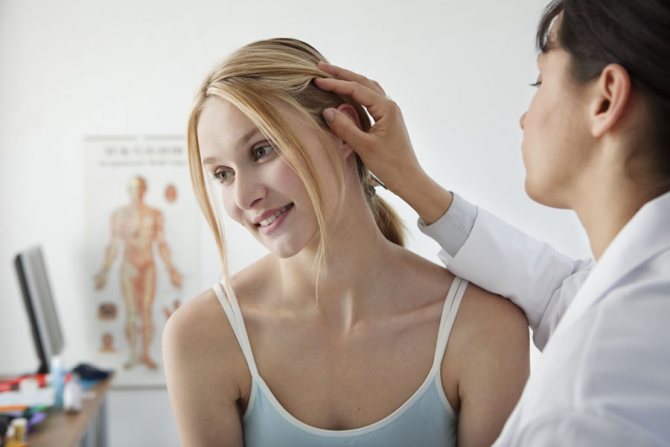
Identifying and treating diseases, the signs of which are rashes on the scalp, stopping the use of tobacco and alcohol, as well as eliminating factors that provoke allergic reactions in the form of cosmetics and chemicals will relieve dermatological problems.
With intense damage and progression of adverse symptoms, drug therapy with antibiotics may be necessary. Along with prescribing such drugs, a dermatologist can prescribe antifungal medications, as well as medications to normalize the microflora of the digestive tract, the condition of which largely determines a person’s overall immunity.
To remove breakdown products of proteins and toxins, sorbents are prescribed; for allergic rashes, antihistamines are prescribed, which effectively relieve unpleasant symptoms. To improve the functioning of the autonomic and central nervous systems and reduce the level of nervousness, prescriptions for sedatives may be written.
A blood test in women is informative regarding the state of the hormonal system. If there is a lack of estradiol production in the body, hormone replacement therapy may be prescribed.
In addition to taking general strengthening agents and a complex of vitamins, external medications in the form of gels, ointments and lotions, as well as physical procedures prescribed in courses, are used to treat acne.
